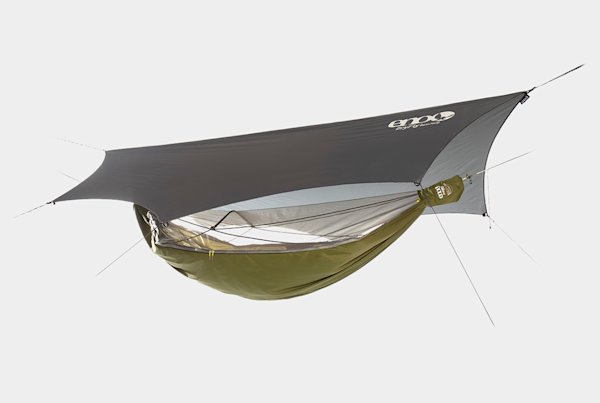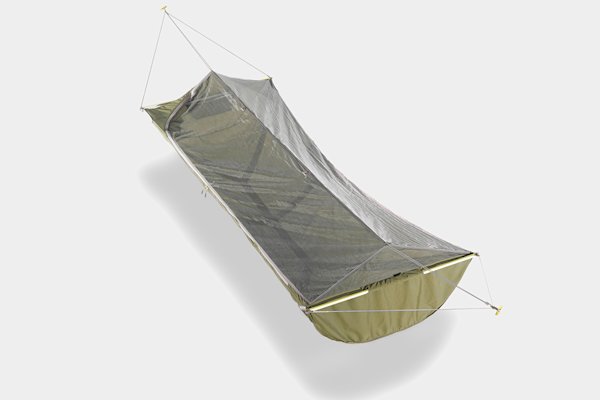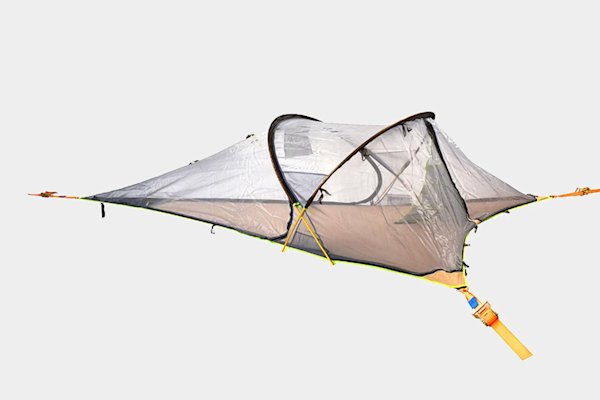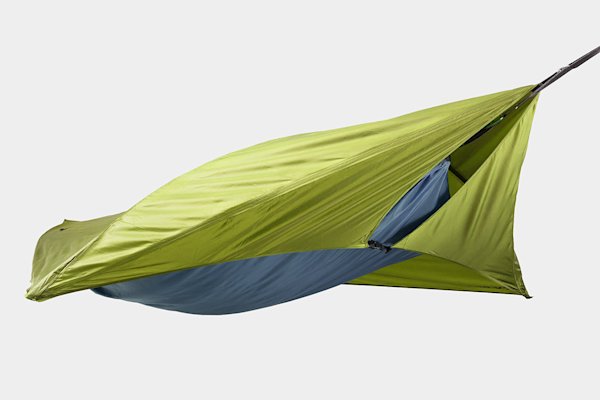Field Mag may receive a minor commission from purchases made via affiliate links.
Hammock tents are a fun way to enhance and elevate—pun intended—your backcountry camping experience. These high-flying shelters are quick to set up, and keep you safe from animals and bugs. Beginners, fear not! Most hammocks are lightweight with suspension systems that make it easy to pitch your shelter in no time (sometimes even faster and more simply than a regular tent).
What is a hammock tent? A hammock tent is precisely what its name suggests: a hybrid between a hammock and a tent. It gives you the sleeping comfort that you get from lying in a hammock, along with the protection from the elements (and bugs) that tent camping provides to form a complete and lightweight shelter system.
For a full rundown of what features to look for in a hammock tent, how to pick the right one, and more, scroll past our top picks for the best hammock tents for a range of uses as chosen by our team of editors and contributors.
Field Mag's Top Picks
- Best Overall: Kammok Mantis All-in-One Hammock Tent
- Best Lightweight Hammock Tent: Hennessy Hammock Ultralite Backpacker Asym Zip Hammock
- Best Ultralight Hammock Tent: Kammok Mantis UL
- Best for General Camping: ENO JungleLink
- Best Tent That’s Also a Hammock: Crua Hybrid
- Best Lightweight Tent That's Also a Hammock: Kammok Sunda 2.0
- Best Lay Flat Hammock Tent: ENO Skylite Hammock
- Best Two Person Hammock Tent: Tentsile Safari 2-Person
- Best Full-Featured Budget Option: Klymit Sky Shelter
- Best Simple Budget Option: Grand Trunk Skeeter Beeter XT
The 10 Best Hammock Tents Of 2024
Best Overall: Kammok Mantis All-in-One Hammock Tent
The three-season, lightweight Kammok Mantis All-in-One checks all the boxes for a quintessential one-person tent hammock. It has a connected no-see-um mesh bug net, rain fly, built-in pockets, and soft, comfortable and high-quality materials. The hammock itself is Kammok's proprietary and comfy ripstop nylon. Using a knotless suspension that includes two of the brand's patented carabiners, it has a remarkably easy setup process and tears down quickly, fitting into a compact bag for easy packability. Unlike many other hammock tent setups, the Mantis comes with everything you need to get camping, including webbing straps for hanging.
Weight: 2 lbs 12 oz (packaged weight); 1 lb 11.8 oz (trail weight)
Weight Capacity: 500 lbs
Price: $250
Best Lightweight Hammock Tent: Hennessy Hammock Ultralite Backpacker Asym Zip Hammock
With a minimalist, asymmetrical design for both the hammock and adjustable rain fly, the Hennessy Hammock Ultralite Backpacker Asym Zip offers both three-season protection and support for up to 200 pounds while weighing just under two pounds. An integrated ridgeline provides back support and structure, and the no-see-um mesh protects from bugs and increases ventilation. Another cool feature is that you can use your hiking or trekking poles to convert the hammock into a ground tent or lounge/chair.
Weight: 1 lb 15 oz (packed and trail weight)
Weight Capacity: 200 lbs
Price: $240
Best Ultralight Hammock Tent: Kammok Mantis UL
At 1 pound 3 ounces, the Mantis UL is lighter than Hennessy Hammock's Expedition Asym, but it's also $30 more expensive. If you're okay with that cost though, it's the lightest full hammock tent setup you can get, and includes everything you'll need to go camping, including an integrated rainfly and insect net, both of which you can remove when they're not needed (ultralight hikers can leave these at home for an even lower trail weight). This high-quality hammock tent also includes straps, stakes, and guy outs.
Weight: 2 lbs 4 oz (packed weight); 2 lbs (trail weight)
Weight Capacity: 300 lbs
Price: $270
Best for General Camping: ENO JungleLink
ENO aka Eagles Nest Outfitters helped make hammock camping a thing with its award-winning and wildly popular DoubleNest Hammock ($75). Stretching 10 feet long with an attached, canopy-like bug net that provides height and protection from insects, the Eno JungleLink adds to that design with a roomy interior and great structural support thanks to a lightweight, no-knots-needed integrated Helios suspension system. An eight-point DryFly rain tarp secures with included guylines and provides maximum coverage from rain and wind, and set-up and break-down is streamlined thanks to the integrated stuff sack attached to the end of the hammock.
Weight: 3 lbs 3 oz (packed weight); 2 lbs 15 oz (trail weight)
Weight Capacity: 300 lbs
Price: $210
Best Tent That’s Also a Hammock: Crua Hybrid
Designed to function as either an on-the-ground tent or a hangable hammock tent, the Crua Hybrid’s innovative and versatile design features a supported frame that will stay in place whether in the air or on the ground, anti-bug mesh for protection and breathability, waterproof flysheet, and reflective aluminium interior lining to regulate temperatures. Capable of being used year-round in all kinds of weather, it comes in one-person and twin sizes.
Weight: 5 lbs (trail weight)
Weight Capacity: 330 lbs
Price: $300
Best Lightweight Tent That's Also a Hammock: Kammok Sunda 2.0
The Sunda is another great tent-first-hammock-second that works well on the ground and in the air. It looks just like a typical backpacking tent—and weighs about the same as one at 4 lbs 3.5 oz, which is lighter than the Crua model above. But thanks to its innovative design, the Sunda can be pitched in midair without the addition of a complicated process. Then Sunda is a spacious two-person tent on the ground, but in hammock mode it's definitely more comfy for one. This duality makes it a good option for car camping since it'll work in any environment.
Weight: 6 lbs 2.5 oz (packed weight); 4 lbs 3.5 oz (trail weight)
Weight Capacity: 400 lbs
Price: $420
Best Lay Flat Hammock Tent: ENO Skylite Hammock
As compared to other hammock tents that use the standard hammock-like scoop hang, the ENO Skylite has a flat lay design, providing a mostly even, supported platform to sleep on for better ergonomic comfort (we say "mostly" because no hammock tent is going to be 100% flat). This is achieved through a unique framing system, using an aluminum spreader bar to stretch the hammock flat, while also allowing for a no-fuss setup. With an integrated bug net, it’s also extremely lightweight and is a great option for the camper who needs better ergonomic support.
Weight: 2 lbs
Weight Capacity: 250 lbs
Price: $170
Best Two-Person Hammock Tent: Tentsile Safari 2-Person
Made with heavy duty, UV-resistant materials that can support up to 880 pounds, the 2-Person Tentsile Safari uses a three-point anchor system to elevate the tent above the ground, with a unique floor calibration system to keep all areas and occupants equally supported. The built-in insect mesh canopy can be rolled away to create an open-air platform, or attached with a rain fly should bad weather hit. Ideal for weekend trips or as a basecamp, set-up is also straightforward and easy and there’s ample storage, with internal pockets and two underfloor nets. The same design is also available for three people.
Weight: 24.7 lbs
Weight Capacity: 880 lbs
Price: $819
Best Full-Featured Budget Option: Klymit Sky Shelter
Capable of holding up to 300 pounds, the Klymit Sky Shelter has a lay-flat hammock area that is protected from the elements with a rain fly that can either be cocooned around the hammock for storm protection, or stretched out to create shade. Combined with the sturdy fabric and customizable design options, it’s ideal for bare-bones, no frills weather protection on backpacking or camping trips.
Weight: 4.7 lbs (with rain fly and stakes); 2.9 lbs (hammock only)
Weight Capacity: 300 lbs
Price: $130
Best Simple Budget Option: Grand Trunk Skeeter Beeter XT
The cheapest way to go hammock camping would be to forgo the integrated shelter and sleep in the open air if it weren't for Grand Trunk's Skeeter Beeter XT. The hammock has an integrated mosquito net with tent features including structure, thanks to collapsible aluminum poles, and a suspended gear loft. It won't keep you dry should it rain, and you can't remove the bug net, but its construction feels nice and roomy while some of the other options can be claustrophobic for some campers. The straps aren't included, but are only $20-$30 extra.
Weight: 2 lbs 2 oz (without straps)
Weight Capacity: 400 lbs
Price: $90

Features to Look for When Buying a Hammock Tent
Weight
The weight of a hammock tent depends on its construction, material, and features. If you're looking for a backpacking hammock, you'll need to consider its weight and how it will affect your camping experience. Ultra lightweight models are ideal for ultralight backpacking and hiking. On the other hand, heavier models often have more features that add to comfort like bug nets, rain flys, aluminum poles, and stakes, and thus tend to be less packable and heavier.
Size
Longer and wider hammocks will generally be more comfortable, especially if you have a bigger build. You might bring things inside in your hammock tent too, just like you would when sleeping on the ground, though note that hammocks get crowded quickly. Two-person or double hammock setups exist and can be more comfortable as a solo camper if you're okay with caring a bit extra weight. For what it's worth, we haven't figured out how to comfortably sleep two people in a hammock, even ones that are advertised as such.
Strength & Weight Capacity
Hammock camping tents have a maximum user weight. When you're looking at hammock tents, remember that the maximum weight refers to the total weight you plan to place in the tent. That includes your bags, food, and equipment and does not only refer to the physical weight of the person(s) who will be sleeping in it. Most hammocks have big ranges and you won't need to worry about this, though some of the ultralight options, like Hennessy Hammock's Expedition Asym ($170), have lower strength ratings.

Insulation
Hammock tents are suspended in midair. That means even a slight summer breeze could leave you feeling chilly during the night—so-called cold butt syndrome is a real thing! But there are solutions that go beyond the waterproof rainfly and sleeping bag you're already using that'll let you go hammock camping in colder climates and in cold weather.
One is to use a sleeping pad inside your hammock. Smaller ultralight and single-person hammocks might not accommodate the same pad you use in your tent, so be sure to check dimensions. Some hammocks (though not any featured in our guide) are double-layered, featuring a sleeve on the bottom where you can insert a sleeping pad.
Another option for adding additional insulation is to use an underquilt. An underquilt attaches to the bottom of your hammock tent and provides insulation from the cold air. Although an underquilt is an additional expense, it's an excellent way to stay warm while keeping the weight of your camping gear down.
Straps
Most hammocks aren't sold with straps you need to suspend them and you'll have to buy them separately (they usually cost around $20-$30). Every company that makes camping hammocks also makes straps for hanging them, but you can also use a standard whoopie sling if you already have one, though they're more difficult to adjust.
Hammock straps are usually just two strong straps with multiple small loops. The tree strap is wrapped and secured around a tree, and your hammock then clips onto one of the loops. It's a good idea to look for longer straps as it will give you more options when you are looking for a place to suspend your hammock.

Benefits of Hammock Tent Camping
Comfort
Sleeping in a suspended cocoon keeps you off of the hard and rocky ground. Add a rain tarp and mozzie net, and you have the perfect combination to what may be the best outdoor sleeping experience you can get.
Versatility
Hammock shelters, especially hybrid hammock tents, provide you with multiple options of where you can set up your tent. They are lightweight and easy to pack—great for a day at the beach or even just for setting up a comfortable spot in your backyard. Many brands also make a full range of accessories to go with the hammock tents they produce, from bug nets to rain flys to freestanding hammock stands for when there aren't any trees around.
Easy Setup
Hammock setup is often easy. In many cases, they are even more straightforward and less time-consuming to set up than a traditional tent.
Packability
Generally speaking, a hammock camping setup will be lighter and take up less space in your backpack or outdoor gear bin. Most of the hammock systems on this list come with integrated stuff sacks to make packing them straightforward and easy, too.

Is it better to sleep in a hammock or on the ground?
The answer to this question is entirely up to you, what you find comfortable, and how you like to sleep outdoors. If swinging freely, suspended between two noble trees while the wind occasionally rocks you side to side as you drift away while listening to the sounds of nature appeals to you, sleep in a hammock. (Just remember that you might want to use an underquilt or sleeping pad as insulation.) If you prefer stability, groundedness, and zippered doors between your sleeping self and nature, go for a tent; you'll still feel immersed in the outdoors. Some people find hammocks uncomfortable for a full night of sleep, so consider that, too.
Are hammock tents worth it?
Most hammock tents are either more affordable than or as affordable as comparable tents, and can provide as much comfort and protection for sleeping outside depending on the type of camping you're doing and where you're doing it. Hammock tents can be a good option particularly for solo campers, since they tend to be smaller and lighter than single-person tents when it comes to packing and hiking.
Published 05-12-2021
Updated 06-28-2023























